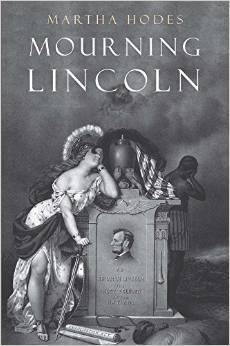NYT History Book Reviews: Who Got Noticed this Week?
One of this week's reviewers, a Harvard professor, Jill Lepore, has a number of things in
common with me:
1. She was affiliated with the Air Force.
2. She played sports, and she failed her math classes. (Yes,
high school algebra is among my mortal enemies.)
3. She wanted to be a writer, but didn't have a clue as to
how to make a career out of it. I'm still in the nitty-gritty processes of
getting a foothold and trying to build my own hut in the sand, so to speak, in
the literary and journalism field.
To the matter at
hand:
Jill reviewed not one, but two books, in her NYT’s review, Mourning Lincoln and 'Lincoln's Body.
Mourning Lincoln by Martha Hodes captures the full range of the
public's responses to the assassination of Abraham Lincoln, which occurred on
April 14, 1965, just days after Confederate surrender. The book is the first of
its kind to delve into the personal and intimate responses of everyday people
of all ethnicities, levels of wealth, and positions in the Civil War, in terms
of if they were friend or foe to the lanky political behemoth.
The Reviewer Said:
"Americans began draping themselves
in black only moments after word spread that the president was dead, as Hodes
writes in her lyrical and important new study.”
The White House was also draped in black mourning adornments
after President James Garfield's death in 1881.
Jill thought that Mourning
Lincoln was a close and deeply disturbing study of how it seemed, to
Americans who disagreed with one another, that "Lincoln’s assassination
stopped the world."
Lincoln's Body by Richard Wightman Fox was written by a white
man who is downright foxy. Alright, I don't mean that, I've never met the man,
but the book he authored sets out to engage the reader with his explorations of
why an odd looking man, awkward in stature and countenance, could mean so much
to a beleaguered nation. Honest Abe's rough appearance made him seem like an
everyman - common, one of us, as did his sense of self-deprecating humor about
his height and large feet. The reviewer describes this book as "fascinating" as well as "an astonishingly interesting interpretation
of the uses to which Lincoln has been put in the century and a half since, in
speeches and statues, in plays and films, in poems and paintings."
Grave robbers actually attempted to steal Lincoln’s corpse,
believe it or not, in 1876. A gang of Chicago counterfeiters attempted to
confiscate Lincoln's body - what was left of his infamous beard and all - from
his tomb in Oak Ridge Cemetery in Springfield, Illinois. It was protected by
just a single padlock. Nowadays, we’d call that old school security measures. Their
scheme was to hold the corpse for a ransom of $200,000 and obtain the release
of the gang’s best counterfeiter from prison. Secret Service agents managed to
infiltrate the gang and ambushed them. Lincoln’s body was consequently moved to
an unmarked grave and eventually encased in a steel cage and entombed under 10
feet of concrete. Since then, his coffin has been opened five times. Give the man some peace, will ya?
The Bottom Line:
The reviewer had very positive things to say about both recent publications.
For Fun: Mr.
Lincoln had a particular weakness
for kittens. One friend from his New Salem days recalled that he “would take
one & turn it on its back & talk to it for half an hour at a time.”
Mrs. Lincoln did not share her husband’s indulgence of pets
and people. She asked: “Don’t you think it’s shameful to feed Tabby with a gold
fork?” Lincoln replied: “If the gold
fork was good enough for James Buchanan, I think it is good enough for Tabby.”
